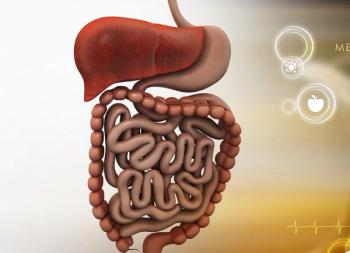
Greater Benefit With Trastuzumab Deruxtecan Vs T-DM1 Observed in Previously Treated HER2+ Breast Cancer
Data from the phase 3 DESTINY-Breast03 trial show trastuzumab deruxtecan bests trastuzumab emtansine in patients with previously treated HER2-positive metastatic breast cancer.
Data from the DESTINY-Breast03 trial (NCT03529110) exhibited superior progression-free survival (PFS) of fam-trastuzumab deruxtecan-nxki (Enhertu) vs trastuzumab emtansine (T-DM1; Kadcyla) in patients with previously treated HER2-positive metastatic breast cancer and is the first trial to compare the 2 options, according to a presentation at the
The median PFS for patients treated with trastuzumab deruxtecan was not reached (95% CI, 18.5-not estimable [NE]) vs 6.8 months (95% CI, 5.6-8.2) with T-DM1 (HR, 0.28; 95% CI, 0.22-0.37; P = 7.8 x 10-22). Among the 261 patients in the trastuzumab deruxtecan arm, the 12-month PFS rate was 75.8% (95% CI, 69.8%-80.7%) vs 34.1% (95% CI, 27.7%-40.5%) among 263 patients treated in the T-DM1 arm.
“These data support trastuzumab deruxtecan becoming the standard of care for the second-line treatment of HER2-positive metastatic breast cancer,” said Javier Cortés, MD, in a presentation of the data. Cortés is head of breast cancer and gynecological cancers at Hospital Universitario Ramón y Cajal in Madrid, Spain, and a clinical investigator for the breast cancer research program at Vall d’Hebron Institute of Oncology in Barcelona, Spain.
In reference to the Kaplan-Meier curves for PFS, Cortés said that there is a “clear and early separation of the curves starting at time of first scan after treatment and proceeding throughout.”
In a discussion of the abstract, Shanu Modi, MD, called attention to the early separation as well saying, “If the waterfall plot from DESTINY-Breast01 was dramatic, I think these PFS curves from DESTINY-Breast03 are startling as is the hazard ratio of 0.28 and the P value of 10-22.” Modi is a medical oncologist at Memorial Sloan Kettering Cancer Center in New York City, New York.
The median overall survival (OS) was NE in both arms (HR, 0.56; 95% CI, 0.36-0.86; P = .007172). The 12-month OS rates were 94.1% (95% CI, 90.3%-96.4%) in the trastuzumab deruxtecan arm vs 85.9% (95% CI, 80.9%-89.7%) in the T-DM1 arm.
The OS data did not cross the prespecified boundary of P < .000265; however, Cortés noted that this is likely because of immature follow-up of the OS data. Investigators observed relatively few events in each arm at the time of analysis (33 and 53 with trastuzumab deruxtecan and T-DM1, respectively).
DESTINY-Breast03 randomized 524 patients with HER2-positive metastatic breast cancer, previously treated with trastuzumab and taxane, to receive either trastuzumab deruxtecan 5.4 mg/kg every 3 weeks or T-DM1 3.6 mg/kg every 3 weeks. Patients with clinically stable, treated brain metastases were eligible for enrollment.
The primary end point was PFS by blind independent central review. A key secondary end point was overall survival and other secondary end points included objective response rate (ORR) by BICR and investigator assessment, duration of response by BICR, PFS by investigator, and safety.
Stratification factors for the analysis included hormone receptor status, prior treatment with pertuzumab (Perjeta), and history of visceral disease. The median follow-up was 16.2 months for the trastuzumab deruxtecan group and 15.3 months for the T-DM1 group.
Baseline characteristics were well balance between the treatment arms: 50.2% vs 51% had a positive hormone receptor, 23.8% vs 19.8% had brain metastases, and 70.5% vs 70.3% had visceral disease, respectively. The median age was 54.3 years (range, 27.9-83.1) vs 54.2 years (range, 20.2-83), respectively.
Nealy half of the patients enrolled to the study had only 1 line of prior therapy in the metastatic setting (49.8% vs 46.8%, respectively). The percentage of patients who received 2 prior therapies was 21.5% in the trastuzumab deruxtecan arm vs 24.7% in the T-DM1 arm. Of note, both groups included a handful of patients who had received 5 or more prior lines of therapy (8.8% vs 6.8%, respectively).
In the trastuzumab deruxtecan arm 62.1% of patients had prior pertuzumab and 16.1% received another anti-HER2 tyrosine kinase inhibitor; these rates were 60.1% and 13.7%, respectively, in the T-DM1 arm.
The data cutoff for interim PFS analysis was May 21, 2021.1 Of note, on July 30, 2021, the independent drug monitoring committee recommended that investigators unblind the study.2
“At the time of this analysis more than 50% of patients remain on trastuzumab deruxtecan [n = 132] compared with 18% of patients on T-DM1 [n = 47],” Cortés said.
In a PFS analysis by investigator assessment, the median PFS was 25.1 months (95% CI, 22.1-NE) in the trastuzumab deruxtecan arm vs 7.2 months (95% CI, 6.8-8.3) in the T-DM1 arm (HR, 0.26; 95% CI, 0.20-0.35; P = 6.5 x 10-24). The 12-month PFS rates were 76.3% (95% CI, 70.4%-81.2%) vs 34.9% (95% CI, 28.8%-41.2%), respectively.
“Improved efficacy with trastuzumab deruxtecan exists across all prespecified subgroups including hormone receptor status, prior pertuzumab treatment, the presence of visceral disease, number pr prior lines of therapy, and presence of absence of brain metastases,” Cortés said.
In the discussion, Modi called attention to the PFS data for patients with treated and stable brain metastases, the median PFS was nearly 3 times longer with trastuzumab deruxtecan (n = 62) compared with T-DM1 (n = 52). The median PFS was 15.0 months (95% CI, 12.6-22.2) vs 5.7 months (95% CI, 2.9-7.1) with T-DM1 (HR, 0.3796; 95% CI, 0.2267-0.6357). “This is a very clinically important difference to highlight between these 2 agents,” Modi said.
The ORR and best overall response data also favored trastuzumab deruxtecan. Specifically, the confirmed ORR in the trastuzumab deruxtecan arm was 79.7% (95% CI, 74.3%-84.4%) vs 34.2% (95% CI, 28.5%-40.3%) in the T-DM1 arm (P < .0001).
Of the responders in the trastuzumab deruxtecan arm 16.1% had a complete response (CR) and 63.6% had a partial response (PR). Among responders in the T-DM1 arm 8.7% had a CR and 25.5% had a PR. Stable disease was reported for 16.9% and 42.6% of patients, respectively. The disease control rate (CR plus PR plus stable disease) was 96.6% with trastuzumab deruxtecan vs 76.8% with T-DM1.
Modi noted that the ORR with trastuzumab deruxtecan was comparable to that seen with pertuzumab/trastuzumab/docetaxel (80.2%) in the first line in results from the phase 3 CLEOPATRA study (NCT00567190).3 “It’s exciting to see that 16% of patients on trastuzumab deruxtecan had a CR,” Modi said. “We recall in CLEOPATRA that number was 5.5%, so interesting to speculate if we will see a larger proportion of patients with long-term disease remission in the trastuzumab deruxtecan arm.”
In terms of safety, the incidence of grade 3/4 drug-related treatment-emergent adverse effects (TEAEs) was 45.5% with trastuzumab deruxtecan vs 39.8% with T-DM1. This difference extended to incidence of serious drug-related TEAEs (10.9% vs 6.1%, respectively), drug-related TEAEs associated with discontinuation (21.4% vs 12.6%), and drug-related TEAEs associated with dose reductions (21.4% vs 12.6%).1
The median treatment duration was 14.3 months (range, 0.7-29.8) for patients who received trastuzumab deruxtecan vs 6.8 months (range, 0.7-25.1) for those who received T-DM1.
Interstitial lung disease (ILD)/pneumonitis was the most common TEAE associated with treatment discontinuation for trastuzumab deruxtecan (8.2%); thrombocytopenia was the most common TEAE that led to discontinuation of T-DM1 (2.7%).
TRAEs associated with dose reduction for trastuzumab deruxtecan were nausea (6.2%) and neutropenia (3.5%) and for T-DM1 were thrombocytopenia (4.2%), alanine aminotransferase (2.7%), and aspartate aminotransferase increase (2.7%).
No drug-related deaths occurred in either arm.
Most drug-related TEAEs were gastrointestinal or hematologic. The most common grade 3 or higher TRAEs with trastuzumab deruxtecan were neutropenia (19.1%), thrombocytopenia (7.0%), nausea (6.6%), leukopenia (6.6%), and anemia (5.8%). For T-DM1, the most common TEAEs grade 3 or higher were thrombocytopenia (24.9%), aspartate aminotransferase increase (5.0%), alanine aminotransferase increase (4.6%), and anemia (4.2%).
“If the efficacy was impressive, I would say the safety [data] from DESTINY-Breast 03 was reassuring,” Modi said, adding that “there were no bad surprises in this trial. T-DM1 certainly sets a high bar for antibody-drug conjugate safety, and I think that is one of its great strengths.”
Lower Rates of ILD Are Encouraging
Modi said that in terms of treatment discontinuation because of TEAEs, lung toxicity with trastuzumab deruxtecan was expected. “Lung toxicity was one of the highly anticipated outcomes from this trial and T-DM1 [had an approximate] 2% incidence of low-grade events,” Modi said. “In comparison trastuzumab deruxtecan had a risk of [10.5%], so 5-fold higher than T-DM1, but lower than that seen inn DESTINY-Breast01 [NCT03248492].”
Most importantly, Modi added, no grade 4 or 5 ILD/pneumonitis events were observed, “a major difference from DESTINY-Breast01 and a major relief.”
In terms of why less lung toxicity was observed in DESTINY-Breast03, it may be because the trial included a patient population that that was less heavily pretreated and therefore exposed to few lines of cancer therapy and stricter patient selection; however, Modi said that this rationale is only a hypothesis at this time.
“Of course, there was also greater awareness [concerning ILD],” Modi said. “There was a large education campaign around the lung toxicity of trastuzumab deruxtecan. If you look at the rates of ILD, the rates were consistent until 2019 when updated management guidelines were implemented and following this incidence rates started to come down.”
Specifically, Modi presented pooled data that demonstrated the incidence of any-grade ILD overtime was 24.3% (n = 18/74) in 2016; 19.6% (n = 33/168) in 2017; 15.3% (n = 87/569) in. 2018; 15.6% (n = 28/179); and 6.9% (n = 11/160) in 2020.4
Based on what is known about trastuzumab deruxtecan, both Cortés and Modi stated that the unmatched efficacy and reduced risk of lung toxicity, support the use of trastuzumab deruxtecan in the second-line setting.1,2
Trastuzumab deruxtecan is approved for patients with unresectable, metastatic HER2-positive breast cancer who have received 2 or more prior lines of anti–HER2-based regimens in the metastatic setting.5
References
- Cortés J, Kim SB, Chung WP, et al. Trastuzumab deruxtecan (T-DXd) vs trastuzumab emtansine (T-DM) in patients (Pts) with HER2+ metastatic breast cancer (mBC): results of the randomized phase III DESTINY-Breast03 study. Presented at: European Society for Medical Oncology Annual Congress 2021. September 16-21, 2021; virtual. Abstract LBA1.
- Enhertu significantly improved progression-free survival in DESTINY-Breast03 head-to-head trial vs. trastuzumab emtansine (T-DM1) in patients with HER2-positive metastatic breast cancer. News release. AstraZeneca and Daiichi Sankyo Company; August 9, 2021. Accessed September 18, 2021. bit.ly/3tRh5zG
- Baselga J, Cortés J, Kim SB, et al; CLEOPATRA Investigators. Pertuzumab plus trastuzumab plus docetaxel for metastatic breast cancer. N Engl J Med. 2012;366(2):109-119. doi:10.1056/NEJMoa1113216
- Powell CA, Modi S, Iwata H, et al. Analysis of study drug-related interstitial lung disease (ILD) inn patiennts (pts) with HER+ metastatic breast cancer (mBC) treated with trastuzumab deruxtecan (T-DXd). Ann Oncol. 2021;32(suppl 2):S61-S62. doi:10.1016/j.annonc.2021.03.106
- Enhertu. Prescribing information. Daiichi Sankyo; 2021. Accessed September 18, 2021. bit.ly/3CtlWKm
Newsletter
Stay up to date on recent advances in the multidisciplinary approach to cancer.

























































































